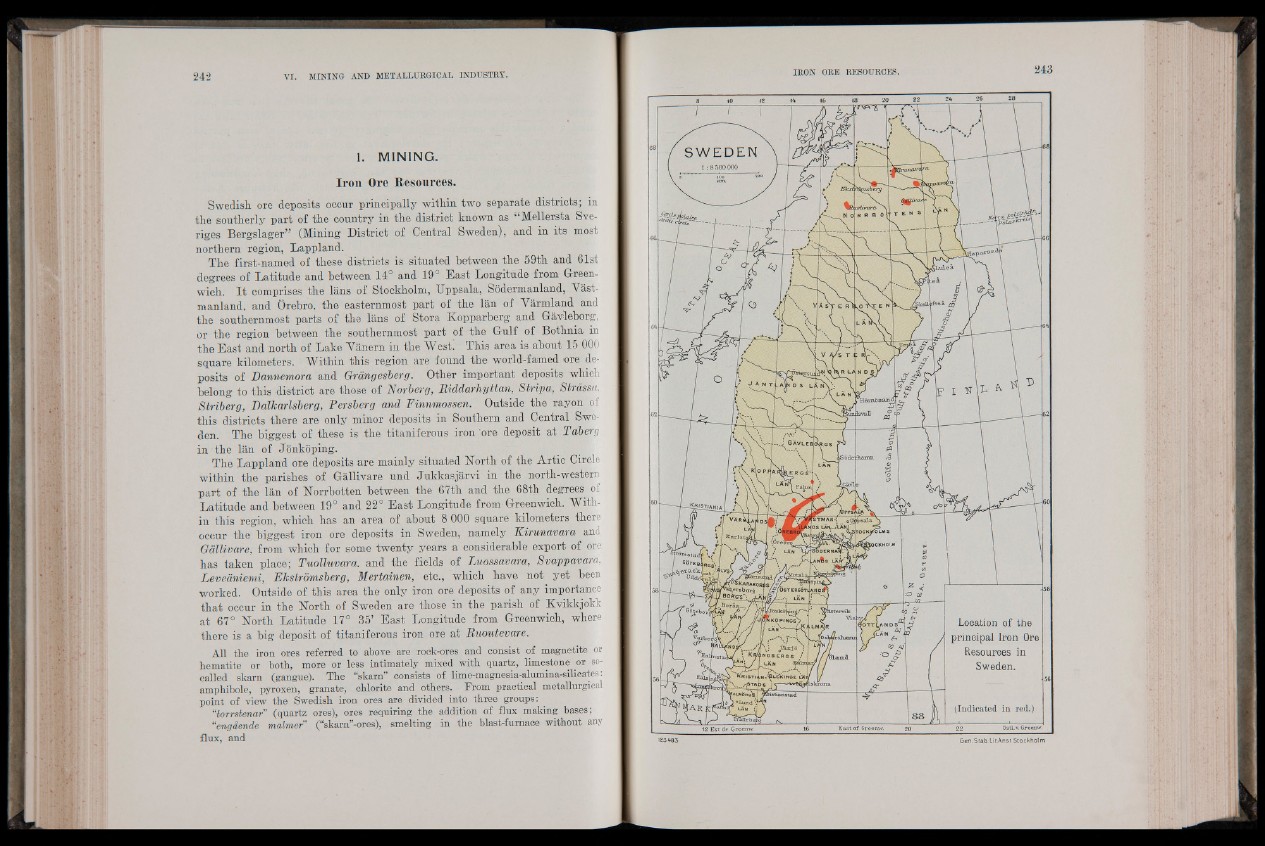
1. MINING.
Iron Ore Resources.
Swedish, ore deposits occur principally within two separate districts; in
the southerly part of the country in the district known as “Mellersta Sve-
riges Bergslager” (Mining District of Central Sweden), and in its most
northern region, Lappland.
The first-named of these districts is situated between the 59th and 61st
degrees of Latitude and between 14° and 19° East Longitude from Greenwich.
It comprises the Ians of Stockholm, Uppsala, Sodermanland, "Vast-
manland, and Örebro, the easternmost part of the lan of Varmland and
the southernmost parts of the Ians of Stora Kopparberg and Gavleborg,
or the region between the southernmost part o f 1 the Gulf of Bothnia in
the East and north of Lake Vanern in the West) This area is about 15 000
square kilometers. Within this region are found the world-famed ore deposits
of Dannemora and Grangesberg. Other important deposits which
belong to this district are those of Norberg, FtiddarJiyttan, Stripa, Strassa,
Striberg, Balkarlsberg, Persberg and Finnmossen. Outside the rayon of
this districts there are only minor deposits in Southern and Central Sweden.
The biggest of these is the titaniferous iron 'ore deposit at Taberg
in the lan of Jonkoping.
The Lappland ore deposits are mainly situated North of the Artie Circle
within the parishes of Gallivare und J ukkasjárvi in the north-western
part of the lan of Norrbotten between the 67th and the 6 8 th degrees of
Latitude and between 19° and 22° East Longitude from Greenwich. Within
this region, which has an area of about 8 0 00 square kilometers there
occur the biggest iron ore deposits in Sweden, namely Kirunavara and
Gallivare, from which for some twenty years a considerable export of ore
has taken place; Tuolluvara. and the fields of Euossavara^ Svappavara,
Leveaniemi, Ehstromsberg, Mertainen, etc., which have not yet been
worked. Outside of this area the only iron ore deposits of any importance
that occur in the North of Sweden are those in the parish of Kvikkjokk
at 67° North Latitude 17° 35’ East Longitude from Greenwich, where
there is a big deposit of titaniferous iron ore at Ruoulevare.
All the iron ores referred to above are rock-ores and consist of magnetite or
hematite or both, more or less intimately mixed with quartz, limestone or so-
called skam (gangue). The “skarn” consists of lime-magnesia-ahimina-silieates:
amphibole, pyroxen, granate, chlorite and others. From practical metallurgical
point of view the Swedish iron ores are divided into three groups:
“iorrstenar” (quartz ores), ores requiring the addition of flux making bases;
“engdende maimer” (“skarn”-ores), smelting in the blast-furnace without any
flux, and
\ p o la r I
,a ra n <
HSmösaxt«
LStMni
> rocKtfOLM:
(Oreoro ICKHOl
lODERMAtf.'
*n o s l a iV
ph’m s t a d F p
K C ! 'JTySKARABOflj /vatiersboré [
LPOfriBS ■ qLÁÍ
.® o r á s _ ./ »,1
jgf / T J /nf
Ö8TERGÖTI AND!
NKÖPINOs'> Location of the
principal Iron Ore
Resources in
Sweden.
iT )lan .d
Kr is t iAn-'-Pl ek in g e lXt
/¡STaId s i c------ f ls k r o n a
«ALMÖHUS
2 °Lund | (Indicated in red.)
Trjffleb,
12 Est de Greenw. E a s t o f G re enw. ÖslLv. Greenw.